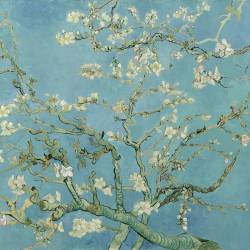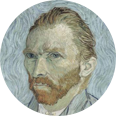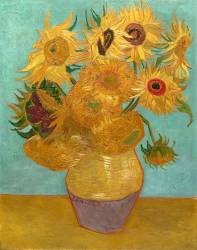Vincent van Gogh
Undoubtedly one of the greatest Dutch painters in the history of art, Vincent Van Gogh was constantly in search of new techniques, in a creative approach that was innovative for the end of the 19th century. A precursor of Fauvism and Expressionism, and a major figure in the post-Impressionist movement, Van Gogh's works aptly represent each period of his life and the evolution of his mental health.
Discover the most emblematic paintings by one of the leaders of the artistic revival at the end of the 19th century, with his "Self-Portrait" of 1889, one of the paintings from his many series of self-portraits that enabled him to experiment with new techniques, "Van Gogh's Bedroom in Arles", a painting representative of the vivid color palette he used at the end of his life, and "Le moulin de la galette, Montmartre", a painting from his Paris period, during which Van Gogh broke away from the academic style.
Treat yourself to one of the reproductions of Van Gogh, the most popular Dutch painter, and discover his biography.
Vincent Van Gogh biography.
Vincent Van Gogh's youth: between art and religion.
Vincent Van Gogh was born in Groot Zundert, in the south of the Netherlands, in 1853. Born into a middle-class family, he spent his entire childhood surrounded by art (his uncles were art dealers) and religion (his own father was a clergyman). From an early age, he produced a few drawings, and it was only natural that, after some difficulty in fitting in at school, he should become an apprentice to his uncle at the Hague branch of Goupil & Cie, one of the most important art dealers of the 19th century. After a stint in London as part of his new job, the young Vincent Van Gogh turned his back on religion, and was eventually dismissed from his job, as he resented art being seen as a mere commodity. Far removed from his future career as a painter, Vincent Van Gogh travelled throughout England, the Netherlands and Belgium between 1876 and 1880, becoming a preacher in the Protestant Church. It was during this period that he came into contact with poverty, and experienced it at first hand as a working-class preacher, which inspired many of his later paintings. During his travels, he never forgot to imbibe the various paintings he discovered in the great museums of the cities, and following the end of his mission as a preacher, he decided, with the advice of his brother Theo Van Gogh, who had decided to embark on a career as an art dealer with Goupil & Cie, to launch himself fully into a career as an artist.
Vincent Van Gogh's first steps as an artist.
In 1880, Vincent Van Gogh decided to move to Brussels, where he studied at the city's Royal Academy of Fine Arts. It was at this point that Theo, who had become manager of the Goupil & Cie branch in Paris, became increasingly involved in the life of his brother Vincent, who moved to The Hague following a tumultuous relationship with his father and part of his family. Between 1881 and 1883, Vincent Van Gogh moved into a small studio, and began to produce sketches and watercolors of his favorite model, Sien Hoornik, a former prostitute he had met in The Hague. He received his first commissions from one of his uncles, the director of an art gallery in the city, but the style of the Dutch painter's canvases was not convincing. For Van Gogh, this period was a time of experimentation, as he sought his own path in a wide range of techniques, from watercolor to oil painting. In 1883, however, he decided to move to the Drenthe region, then back to Nuenen, where his family had settled in 1882. Here, for almost 2 years, he painted peasant portraits, still lifes and landscape reproductions. During this period, Van Gogh's painting was sombre, but his drawing was expressive and synonymous with his great mastery. After a brief stay in Antwerp, where he discovered Japanese prints, Vincent Van Gogh joined his brother in Paris in 1886, in the Montmartre district.
Paris and Arles: Vincent Van Gogh's artistic renewal.
In Paris, Vincent Van Gogh was surrounded by the city's vibrant artistic scene. He, who still painted in a relatively academic style, discovered Impressionism here, particularly around the last Impressionist exhibition, which also welcomed for the first time avant-garde painters from the neo-Impressionist movement, such as Paul Gauguin, Camille Pissarro, George Seurat and Paul Signac. Vincent Van Gogh met these post-Impressionist figures through his brother, but also through the color merchant "Le père Tangy", and drew on all these new techniques to develop his painting style. His palette brightened to include vivid colors, and he began experimenting with flat tints, in the image of Hokusai and Hiroshige in Japanese prints. In addition to giving more and more canvases to his brother, he exchanged many of them throughout the rest of his life with painter friends he met in Paris. In 1888, however, he decided to move to Arles, and set up home at the Maison Jaune, with the idea of creating a genuine artists' community like the one that already existed at Pont-Aven. There, he took up the dated principle of the series of paintings, and created several series based on still life, such as his famous sunflower paintings, but also representations of his environment, such as his bedroom in the yellow house. However, Van Gogh's mental health declined, and during yet another argument with his friend Paul Gauguin, who had come to reflect on their creative process, the Dutch artist cut off his left ear.
Vincent Van Gogh's last works and end of life.
After this outburst of madness, and following a petition signed by the people of Arles for Van Gogh to leave the town, the Dutch painter, in turmoil, decided to enter the Saint Paul de Mausole psychiatric asylum in Saint Rémy de Provence. During his year-long stay at the hospice, he remained very active despite his madness, painting numerous self-portraits, always depicting himself in such a way as to hide his severed ear, as well as paintings that would become precursors of Expressionism with those by Edvard Munch, such as "Starry Night", "Wheatfields with Cypresses" or the depiction of the "Olive Trees" and the Alpilles visible from his window. In 1890, Vincent Van Gogh moved closer to Paris and his brother, settling in Auvers-sur-Oise. It was here that he spent the rest of his life, followed by Doctor Gachet, whose portrait he painted, which became the most expensive oil on canvas in Van Gogh's oeuvre. Despite the care he received and the plethora of work he produced in just 70 days, including his last painting, "Racines d'arbres" ("Tree Roots"), Vincent Van-Gogh succumbed to his wounds on July 29, 1890, two days after a final fit of madness in which he shot himself in the chest with a revolver.
Vincent Van Gogh: late recognition.
Today, Vincent Van Gogh is one of the most sought-after artists on the art market, and one of the most famous painters in Dutch, as well as international, painting. However, this passionate character received little recognition during his lifetime. A trailblazer in many fields, and a friend to many of the avant-garde painters of the late 19th century, Van Gogh was nonetheless well known to his peers. It was thanks to the work of Johanna Bonger, his brother Theo's widow, that van Gogh's paintings gained a real reputation with the general public, and that the artist became famous. Thanks to the large collection she owned, she organized a number of exhibitions, and the painter gradually gained an immense reputation in the early 20th century. Today, the painter's works can be found in many museums around the world, from the Van Gogh Museum in Amsterdam and the Kröller-Müller Museum in Otterlo in the Netherlands, to MoMA in New York, the Musée d'Orsay and the Rodin Museum in France, and many buildings have been named after him, such as the Espace Van Gogh in Arles, the former hospital where he stayed.
Learn more about the life and the works of Vincent van Gogh.Van Gogh high quality framed art prints, on fine art paper or canvas

See all
artworks from
Vincent van GoghDiscover
- 30% !
Make good deals by browsing our Reserve : editions of our catalog which await their purchaser at a low price.










































